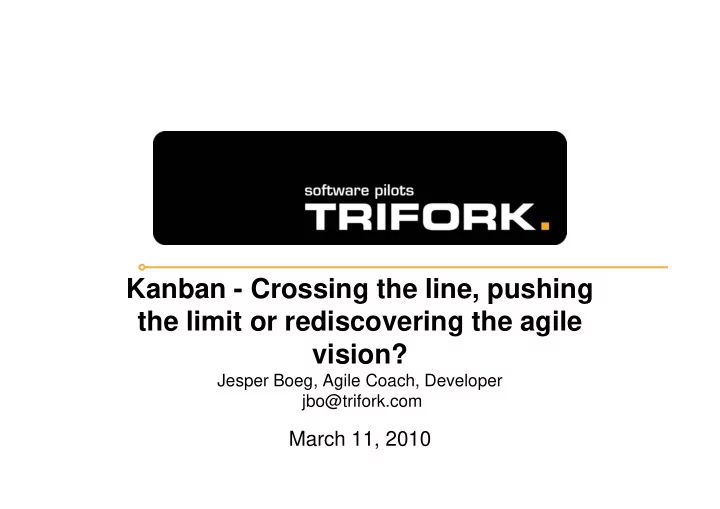

Kanban - Crossing the line, pushing the limit or rediscovering the agile vision? Jesper Boeg, Agile Coach, Developer jbo@trifork.com March 11, 2010
In general � Feel free to ask questions – I much prefer an enthusiastic discussion over missing a few slides – Might also keep you from taking your lunch time nap ☺ � I am not a PowerPoint black belt so please bear with my less than fancy slides
Agenda � Kanban origins � What is software Kanban? � How is software Kanban different from other agile methods and which problems other agile methods and which problems might it help us solve? � Disadvantages � Software Kanban and team maturity � Last notes
KANBAN IN MANUFACTORING
������ ���������������� � ������ ���������������������� ������������������������������� ������������ � ���������������������������� ������������������������������ ������������������������������� ������������������������������� � !������������������������������ ������������������������������� ������������ � ������ ��������������������� ������������������������������ "#$������������������������ � %������������������������������� ���� 5
A simple example of a Kanban pull system � New paper is ordered when the limit prescribed by the kanban is reached reached � When paper arrives the kanban Order is returned along Paper with the paper
KANBAN IN SOFTWARE
Software Kanban uses a broader Lean perspective � Limit work in progress. – Focus on flow – Deliver often � Focus on quality – stop the line � Balance demand and throughput – Getting people home at night – Finding the right bottleneck – Having free time on your hands – Optimizing the whole � Continuous improvement – Keep getting better � Prioritize – Focus on business value and minimal marketable feature set
To achieve this � Start by mapping the value stream and track work on a white board
Define WIP limits for each stage
Pick the low hanging fruits � You will be surprised how much you can achieve by – Limiting work in progress. – Limiting work in progress. – Balancing demand and throughput
How does that fit with current Agile best practices? � You can do fixed iterations or not – As long as you deliver often � You can use iteration retrospectives or not – As long as you focus on continuous improvement improvement � You can use estimation or not – As long as you are able to do necessary planning � You can leave out iteration retrospectives – If you replace them with spontaneous quality circles or a better way to continuously improve
But that does not mean � It is illegal to do iterations – If doing iterations will increase flow � It is illegal to estimate – If estimation provides valuable information to stakeholders and motivates developers stakeholders and motivates developers � It is not possible to do release planning – Release planning can be done on other metrics e.g. cycletime or average number of items completed � You are not focusing on improving the way you work
Typical measurements � Cycle time – Measured from when you started working on it � Lead time – Measured form when the customer ordered � Quality � Quality – Time spend bugfixing per iteration � WIP – Average number of “stories” in progress � Throughput – Number of “stories” completed per iteration (when using fixed iterations)
Use Cumulative Flow diagrams http://leanandkanban.files.wordpress.com/2009/04/cfd-example.jpg
Focusing on value sets instead of practices � Using Kanban focus is no longer on specific practices – Choose practices that will help you use resources at hand most effectively in your resources at hand most effectively in your context � You might end up doing Scrum ☺ – If Scrum practices are the perfect way to limit WIP, build quality in, level throughput and demand and prioritize according to business value in your context
But that is not my practice!! David Anderson: “I don’t care about your practices” � Keep your eye on the ball � Keep your eye on the ball – We are hopefully using best practices because we believe they help us deliver business value to our customers – not because somebody told us to � Once practices become faith based and cargo cult we risk loosing sight of the goal – Remember Alistair Cockburn’s: Shu, Ha, Ri
SO HOW DOES THIS MAKE A DIFFERENCE?
������������������������������� ����������� & '���������������������������������������(���������������� ������������������������������������������������������� �������������������� & %��������������������������������)������* & +�)����������������������������������������������������������� ��������������� ��������������� & '������������������������������������������������������������ �����������������������������������������������)���������������� ����������� & ,����������)��������������������������������������������������� ����������������������������-��! & .����)������������������������������������������/�������������� ����������������������������������%''��������������������� 19
�������������������������� � 0�������������������������������� ���������1 ��������������������� ���� 1 2�������������������3������!������ ����������������������������� 1 2����������������������������� 1 2����������������������������� �����������������)������������ �����������������)������������ ���� 4������������������������������������������������������ �����������������������)������������������������ ������������������������������������������������������� �����
We need to allow more than one cadence David Anderson: “Concept that input cadence, output cadence and cycle time should be synchronous e.g. 2 week iteration, will be seen as edge case 5 years from now” � I don’t know if that will be true but it does seem reasonable to decouple prioritization, delivery and cycle time to wary naturally according to the context and transaction costs – Actually one of the main reasons kanbans are used in manufacturing
Why do we readily accept agile overhead? � Stopping the development team for 1-2 days to do sprint planning � Low quality feedback because functionality is to small to provide business value business value � Stressing the real bottleneck/constraint by protecting the development team from external interruptions � …….
Recommend
More recommend